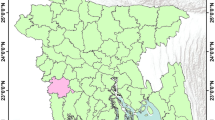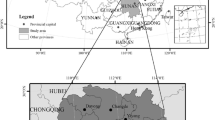Abstract
The accurate and timely mapping of summer maize is vital for agricultural management and food security. Time-series remotely sensed imagery provides a promising data resource for crop mapping by characterizing growth cycles over time. Therefore, this study explores summer maize mapping with composited time-series Sentinel-1A imagery of a typical crop field in China. First, time-series backscattering coefficients of major land-cover types (i.e. summer maize, peanut, forest, settlements, and water) are extracted from multi-temporal Sentinel-1A imagery. Second, according to the growth cycles of summer maize and peanut, the multi-temporal Sentinel-1A images are composited to enhance the characteristics of the summer maize growth cycle, while also eliminating redundant information and differences in phenology. Third, the decision-tree method is used to perform pixel-level classification; samples with an area of 1 km2 are collected as validation datasets. The results show that Sentinel-1A VH-polarized images are more sensitive to the summer maize growth cycle than VV-polarized images. The summer maize cropping areas are estimated with an overall accuracy of 96.55% and a kappa coefficient of 0.93. The results suggest that multi-temporal Sentinel-1A imagery is capable of characterizing the growth cycle of summer maize, and provides a promising solution for accurate summer maize mapping, irrespective of weather conditions.










Similar content being viewed by others
References
Abuzied, S., Ibrahim, S., Kaiser, M., & Saleem, T. (2016). Geospatial susceptibility mapping of earthquake-induced landslides in Nuweiba area, Gulf of Aqaba, Egypt. Journal of Mountain Science, 13(7), 1286–1303.
Arciniegas, G. A., Bijker, W., Kerle, N., & Tolpekin, V. A. (2007). Coherence- and amplitude-based analysis of seismogenic damage in Bam, Iran, using ENVISAT ASAR data. IEEE Transactions on Geoscience and Remote Sensing, 45(6), 1571–1581.
Attema, E. P. W., & Ulaby, F. T. (1978). Vegetation modeled as a water cloud. Radio Science, 13(2), 357–364.
Bouman, B. A. M., & Hoekman, D. H. (1993). Multitemporal, multifrequency radar measurements of agricultural crops during the Agriscatt-88 campaign in The Netherlands. International Journal of Remote Sensing, 14(8), 1595–1614.
Cao, Y. F., Xu, L. L., & Clausi, D. (2017). Exploring the potential of active learning for automatic identification of marine oil spills using 10-year (2004–2013) RADARSAT data. Remote Sensing, 9(10), 1041–1060.
Chen, B. Q., Xiao, X. M., Li, X. P., Pan, L. H., Doughty, R., Ma, J., Dong, J. W., Qin, Y. W., Zhao, B., Wu, Z. X., Sun, R., Lan, G. Y., Xie, G. S., Clinton, N., & Giri, C. (2017). A mangrove forest map of China in 2015: Analysis of time series Landsat 7/8 and Sentinel-1a imagery in Google Earth Engine cloud computing platform. ISPRS Journal of Photogrammetry and Remote Sensing, 131, 104–120.
Dong, J., Fu, Y., Wang, J., Tian, H., Fu, S., Niu, Z., Han, W., Zheng, Y., Huang, J., & Yuan, W. (2020). Early-season mapping of winter wheat in China based on Landsat and Sentinel images. Earth System Science Data, 12(4), 3081–3095.
Duda, T., & Canty, M. (2002). Unsupervised classification of satellite imagery: Choosing a good algorithm. International Journal of Remote Sensing, 23(11), 2193–2212.
Friedl, M. A., & Brodley, C. E. (1997). Decision tree classification of land cover from remotely sensed data. Remote Sensing of Environment, 61(3), 399–409.
Gitelson, A. A., Vina, A., Arkebauer, T. J., Rundquist, D. C., Keydan, G., & Leavitt, B. (2003). Remote estimation of leaf area index and green leaf biomass in maize canopies. Geophysical Research Letters, 30(5), 52–56.
Gorelick, N., Hancher, M., Dixon, M., Ilyushchenko, S., Thau, D., & Moore, R. (2017). Google earth engine: Planetary-scale geospatial analysis for everyone. Remote Sensing of Environment, 202, 18–27.
Gupta, K. K., & Gupta, R. (2007). Despeckle and geographical feature extraction in SAR images by wavelet transform. ISPRS Journal of Photogrammetry and Remote Sensing, 62(6), 473–484.
Hasituya, & Chen, Z. (2017). Mapping plastic-mulched farmland with multi-temporal Landsat-8 data. Remote Sensing, 9(6), 557–583.
Jia, K., Liang, S. L., Zhang, N., Wei, X. Q., Gu, X. F., Zhao, X., Yao, Y. J., & Xie, X. H. (2014). Land cover classification of finer resolution remote sensing data integrating temporal features from time series coarser resolution data. ISPRS Journal of Photogrammetry and Remote Sensing, 93, 49–55.
Jung, H. S., Lu, Z., & Zhang, L. (2013). Feasibility of along-track displacement measurement from Sentinel-1 interferometric wide-swath mode. IEEE Transactions on Geoscience and Remote Sensing, 51(1), 573–578.
Kussul, N., Lavreniuk, M., Skakun, S., & Shelestov, A. (2017). Deep learning classification of land cover and crop types using remote sensing data. IEEE Geoscience and Remote Sensing Letters, 14(5), 778–782.
Li, K., Shao, Y., & Zhang, F. (2011). Rice information extraction using multi-polarization airborne synthetic aperture radar data. Journal of Zhejiang University. Agriculture and Life Sciences, 37(2), 181–186.
Li, Q. T., Wang, C. Z., Zhang, B., & Lu, L. L. (2015). Object-based crop classification with Landsat-MODIS enhanced time-series data. Remote Sensing, 7(12), 16091–16107.
Maldonado, S., Carrizosa, E., & Weber, R. (2015). Kernel penalized k-means: A feature selection method based on kernel k-means. Information Sciences, 322, 150–160.
Mansaray, L. R., Huang, W. J., Zhang, D. D., Huang, J. F., & Li, J. (2017). Mapping rice fields in urban Shanghai, southeast China, using Sentinel-1a and Landsat 8 datasets. Remote Sensing, 9(3), 257–279.
Nagy, A., Feher, J., & Tamas, J. (2018). Wheat and maize yield forecasting for the Tisza river catchment using MODIS NDVI time series and reported crop statistics. Computers and Electronics in Agriculture, 151, 41–49.
Navarro, A., Rolim, J., Miguel, I., Catalao, J., Silva, J., Painho, M., & Vekerdy, Z. (2016). Crop monitoring based on SPOT-5 Take-5 and Sentinel-1A data for the estimation of crop water requirements. Remote Sensing, 8(6), 525–544.
Nguyen, D. B., Gruber, A., & Wagner, W. (2016). Mapping rice extent and cropping scheme in the Mekong Delta using Sentinel-1A data. Remote Sensing Letters, 7(12), 1209–1218.
Plank, S. (2014). Rapid damage assessment by means of multi-temporal SAR—A comprehensive review and outlook to Sentinel-1. Remote Sensing, 6(6), 4870–4906.
Pradhan, B. (2013). A comparative study on the predictive ability of the decision tree, support vector machine and neuro-fuzzy models in landslide susceptibility mapping using GIS. Computers & Geosciences, 51, 350–365.
Rossini, M., Panigada, C., Cilia, C., Meroni, M., Busetto, L., Cogliati, S., Amaducci, S., & Colombo, R. (2015). Discriminating irrigated and rainfed maize with diurnal fluorescence and canopy temperature airborne maps. ISPRS International Journal of Geo-Information, 4(2), 626–646.
Schmidt, K. S., & Skidmore, A. K. (2004). Smoothing vegetation spectra with wavelets. International Journal of Remote Sensing, 25(6), 1167–1184.
Schwieder, M., Leitao, P. J., Bustamante, M. M. D., Ferreira, L. G., Rabe, A., & Hostert, P. (2016). Mapping Brazilian savanna vegetation gradients with Landsat time series. International Journal of Applied Earth Observation and Geoinformation, 52, 361–370.
Shanmugapriya, S., Haldar, D., & Danodia, A. (2020). Optimal datasets suitability for pearl millet (Bajra) discrimination using multiparametric SAR data. Geocarto International, 35(16), 1814–1831.
Sobiech, J., & Dierking, W. (2013). Observing lake- and river-ice decay with SAR: Advantages and limitations of the unsupervised k-means classification approach. Annals of Glaciology, 54(62), 65–72.
Steele-Dunne, S. C., McNairn, H., Monsivais-Huertero, A., Judge, J., Liu, P.-W., & Papathanassiou, K. (2017). Radar remote sensing of agricultural canopies: A review. IEEE Journal of Selected Topics in Applied Earth Observations and Remote Sensing, 10(5), 2249–2273.
Thenkabail, P. S., Biradar, C. M., Noojipady, P., Dheeravath, V., Li, Y., Velpuri, M., Gumma, M., Gangalakunta, O. R. P., Turral, H., Cai, X., Vithanage, J., Schull, M. A., & Dutta, R. (2009). Global irrigated area map (GIAM), derived from remote sensing, for the end of the last millennium. International Journal of Remote Sensing, 30(14), 3679–3733.
Tian, H., Huang, N., Niu, Z., Qin, Y., Pei, J., & Wang, J. (2019). Mapping winter crops in China with multi-source satellite imagery and phenology-based algorithm. Remote Sensing, 11(7), 820–842.
Tian, H. F., Li, W., Wu, M. Q., Huang, N., Li, G. D., Li, X., & Niu, Z. (2017). Dynamic monitoring of the largest freshwater lake in China using a new water index derived from high spatiotemporal resolution Sentinel-1A data. Remote Sensing, 9(6), 521–538.
Tian, H., Wang, J., Pei, J., Qin, Y., Zhang, L., & Wang, Y. (2020). High spatiotemporal resolution mapping of surface water in the southwest Poyang Lake and its responses to climate oscillations. Sensors, 20(17), 4872–4888.
Torres, R., Snoeij, P., Geudtner, D., Bibby, D., Davidson, M., Attema, E., Potin, P., Rommen, B., Floury, N., Brown, M., Traver, I. N., Deghaye, P., Duesmann, B., Rosich, B., Miranda, N., Bruno, C., L’Abbate, M., Croci, R., Pietropaolo, A., … Rostan, F. (2012). GMES Sentinel-1 mission. Remote Sensing of Environment, 120, 9–24.
Van Gasselt, S., Kim, J. R., Choi, Y. S., & Kim, J. (2017). The Oasis impact structure, Libya: Geological characteristics from ALOS PALSAR-2 data interpretation. Earth, Planets and Space, 69, 35–46.
Veloso, A., Mermoz, S., Bouvet, A., Le Thuy, T., Planells, M., Dejoux, J.-F., & Ceschia, E. (2017). Understanding the temporal behavior of crops using Sentinel-1 and Sentinel-2-like data for agricultural applications. Remote Sensing of Environment, 199, 415–426.
Vreugdenhil, M., Wagner, W., Bauer-Marschallinger, B., Pfeil, I., Teubner, I., Ruediger, C., & Strauss, P. (2018). Sensitivity of Sentinel-1 backscatter to vegetation dynamics: An Austrian case study. Remote Sensing, 10(9), 1396–1413.
Wang, J., Wu, C., Wang, X., & Zhang, X. (2019). A new algorithm for the estimation of leaf unfolding date using MODIS data over China’s terrestrial ecosystems. ISPRS Journal of Photogrammetry and Remote Sensing, 149, 77–90.
Wang, J., Xiao, X. M., Liu, L., Wu, X. C., Qin, Y. W., Steiner, J. L., & Dong, J. W. (2020). Mapping sugarcane plantation dynamics in Guangxi, China, by time series Sentinel-1, Sentinel-2 and Landsat images. Remote Sensing of Environment, 247, 111951.
Xie, Y., Wang, P. X., Bai, X. J., Khan, J., Zhang, S. Y., Li, L., & Wang, L. (2017). Assimilation of the leaf area index and vegetation temperature condition index for winter wheat yield estimation using Landsat imagery and the CERES-Wheat model. Agricultural and Forest Meteorology, 246, 194–206.
Xu, L., Zhang, H., Wang, C., Zhang, B., & Liu, M. (2019). Crop classification based on temporal information using Sentinel-1 SAR time-series data. Remote Sensing, 11(1), 53–70.
Yan, L., & Roy, D. P. (2015). Improved time series land cover classification by missing-observation-adaptive nonlinear dimensionality reduction. Remote Sensing of Environment, 158, 478–491.
Yang, J. S., Wang, J., & Ren, L. (2017). The first quantitative remote sensing of ocean internal waves by Chinese GF-3 SAR satellite. Acta Oceanologica Sinica, 36(1), 118–118.
Yu, B., & Shang, S. (2017). Multi-year mapping of maize and sunflower in Hetao irrigation district of China with high spatial and temporal resolution vegetation index series. Remote Sensing, 9(8), 855–870.
Zhai, Y. G., Qu, Z. Y., & Hao, L. (2018). Land cover classification using integrated spectral, temporal, and spatial features derived from remotely sensed images. Remote Sensing, 10(3), 383–408.
Zhang, J. H., Feng, L. L., & Yao, F. M. (2014). Improved maize cultivated area estimation over a large scale combining MODIS-EVI time series data and crop phenological information. ISPRS Journal of Photogrammetry and Remote Sensing, 94, 102–113.
Zhao, J. L., Xu, C., Xu, J. P., Huang, L. S., Zhang, D. Y., & Liang, D. (2018). Forecasting the wheat powdery mildew (Blumeria graminis f. Sp tritici) using a remote sensing-based decision-tree classification at a provincial scale. Australasian Plant Pathology, 47(1), 53–61.
Acknowledgements
This study was funded by the China Postdoctoral Science Foundation (2019M662478), Major project of Collaborative Innovation Center on Yellow River Civilization jointly built by Henan Province and Ministry of Education (2020M19), Natural Science Foundation of Henan (202300410075), National Demonstration Center for Experimental Environment and Planning Education (Henan University) Funding Project (2020HGSYJX009), and the National Natural Science Foundation of China (41871347).
Author information
Authors and Affiliations
Corresponding authors
Additional information
Publisher's Note
Springer Nature remains neutral with regard to jurisdictional claims in published maps and institutional affiliations.
About this article
Cite this article
Tian, H., Qin, Y., Niu, Z. et al. Summer Maize Mapping by Compositing Time Series Sentinel-1A Imagery Based on Crop Growth Cycles. J Indian Soc Remote Sens 49, 2863–2874 (2021). https://doi.org/10.1007/s12524-021-01428-0
Received:
Accepted:
Published:
Issue Date:
DOI: https://doi.org/10.1007/s12524-021-01428-0




